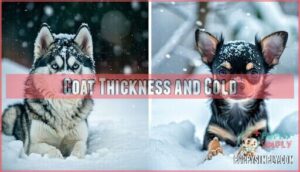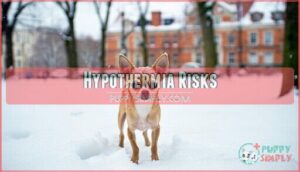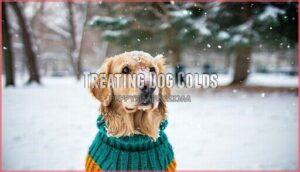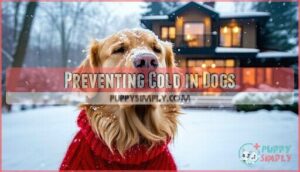This site is supported by our readers. We may earn a commission, at no cost to you, if you purchase through links.
 Yes, dogs get cold, especially in chilly weather.
Yes, dogs get cold, especially in chilly weather.
Even though they’ve got fur, it’s not always enough—just like you wouldn’t wear a T-shirt in a snowstorm.
Small breeds, short-haired dogs, and puppies are more prone to catching a chill.
Signs of cold include shivering, curling up tightly, or lifting their paws off icy ground (a dog’s way of saying, “This is freezing!”).
Keep them warm with cozy jackets, paw protection, or shorter outdoor times when it’s frosty.
While snow-loving breeds like Huskies fare better, remember every dog has its limit.
Curious about more cold-weather tips?
Stay ahead of winter woes!
Table Of Contents
- Key Takeaways
- Can Dogs Get Cold
- Do Dogs Get Cold
- Cold Weather Safety
- Treating Dog Colds
- Preventing Cold in Dogs
- Frequently Asked Questions (FAQs)
- How do I know if my dog got a cold?
- Do dogs get cold at night in the house?
- What type of clothing should I put on my dog in cold weather?
- How long can a dog stay outside in cold weather?
- Is it safe for a dog to be in the snow?
- How does age impact a dogs cold tolerance?
- What indoor activities can keep dogs warm?
- Could illness make dogs more sensitive to cold?
- Are certain dog toys helpful during cold seasons?
- How do changes in diet affect winter warmth?
- Conclusion
Key Takeaways
- Your dog can feel cold weather, especially small breeds, short-haired dogs, puppies, and seniors, so watch for signs like shivering or lifting their paws.
- Protect your pup with jackets, paw balm, or winter booties, and limit outdoor time when temperatures drop below 45°F.
- Hypothermia risks increase in freezing temperatures, with symptoms like pale gums, lethargy, and excessive shivering needing immediate care.
- Keep your dog warm indoors with cozy blankets and adjust their diet with healthy fats and omega-3s for better cold resistance.
Can Dogs Get Cold
Yes, your dogs can feel cold just like you do, especially smaller breeds or those with thin coats when temperatures drop below 45°F.
You’ll need to watch for signs like shivering or reluctance to go outside, as these indicate your furry friend might be experiencing discomfort from the cold.
Outdoor Exposure Risks
Winter’s bite poses real dangers to your furry companion.
Your dog faces significant outdoor exposure risks when temperatures drop below 32°F, especially for small breeds and seniors.
Watch for lifted paws and shivering—early signs of cold stress.
Lifted paws and shivering are your dog’s cry for warmth—protect them from cold stress with extra care.
Windchill effects can accelerate hypothermia risks, while icy surfaces threaten paw injuries.
Always provide adequate shelter during winter outings and wipe paws after walks to remove toxic ice-melting chemicals.
Rottweilers, with their double coat, possess natural cold insulation, but still require monitoring in low temperatures.
Dog winter safety requires vigilance.
Cold Weather Breeds
While many dogs feel the chill, certain breeds are naturally equipped for frigid conditions thanks to their physical adaptations.
These cold weather breeds have remarkable cold tolerance due to their dense double coats and sturdy builds.
Here are 3 notable cold-resistant canines:
- Alaskan Malamutes with their thick fur density and powerful frames
- Samoyeds featuring plush white coats that insulate against extreme temperatures
- Siberian Huskies designed for endurance in sub-zero conditions, which makes them well-suited for cold weather.
Signs of Cold Stress
While your dog can’t tell you they’re freezing, their body sends clear signals.
Watch for shivering, lethargy, and pale gums – these are early dog hypothermia signs.
Cold ears, slow breathing, and reluctance to move indicate your furry friend is struggling with dog cold temperature.
Even if your pup has thick fur, they’re not immune to dog cold weather effects.
Do Dogs Get Cold
Yes, dogs absolutely get cold, though their tolerance varies dramatically. Your furry companion can feel chilly just like you do, especially when temperatures drop below 45°F.
Breed sensitivity plays a vital role – Huskies and Malamutes have natural insulation while Chihuahuas and Greyhounds don’t stand a chance in cold weather. Age factors substantially affect tolerance too; puppies and senior dogs struggle more with temperature regulation.
Size matters as well – smaller breeds lose body heat faster than larger ones. Indoor dogs who aren’t acclimated to outdoor conditions are particularly vulnerable when winter arrives.
Watch for dog cold symptoms like shivering, reluctance to continue walks, or seeking warm spots. Your dog’s cold temperature tolerance isn’t just about their coat – it’s about overall health and conditioning. When your normally energetic pup slows down and hunches their back, they’re telling you they’re uncomfortable.
A dog’s nose temperature, however, isn’t always an indicator, as normal nose temperature can fluctuate.
Cold Weather Safety
You’ll need to protect your dog from freezing temperatures just like you protect yourself, as even the fluffiest pups can suffer in extreme cold.
When the temperature drops, you can prevent cold-related issues by using proper paw protection, considering your dog’s coat thickness, and watching for early signs of hypothermia.
Paw Protection Methods
Your dog’s paws need protection when temperatures drop. Apply paw balm or petroleum jelly to create a barrier against salt exposure and harsh chemicals.
Booties offer complete coverage for sensitive pads during dog winter care. Keep paw hair trimmed to prevent ice buildup and regularly check between toes.
Create safe paths with straw in your yard, and make certain indoor surfaces are warm for your pup’s comfort during dog cold weather. Many owners find that paw balm is helpful in these conditions.
Coat Thickness and Cold
While double-coated breeds like Huskies thrive in frigid temperatures, your short-haired pup lacks that natural insulation.
Coat density directly affects how your dog handles cold weather, with undercoat importance being most evident in winter months.
Breed variations are significant—small dogs shiver cold more quickly than larger breeds with thicker fur.
Proper grooming impact shouldn’t be overlooked either, as matted fur reduces insulation effectiveness.
Understanding your dog’s specific coat type is essential for appropriate dog winter care.
Regular brushing helps prevent shedding and matting.
Hypothermia Risks
Danger lurks in winter temperatures for your furry friend. You’ll need to watch for hypothermia risks, especially with small, young, or elderly dogs who lose heat faster.
Watch for hypothermia signs—shivering, lethargy, and pale gums—small or senior dogs face heightened risk in freezing temperatures.
Five critical signs of dog hypothermia include:
- Excessive shivering and muscle stiffness
- Lethargy or weakness
- Slow breathing and heart rate
- Pale or gray gums
- Confusion or lack of coordination
Remember, severe hypothermia can be life-threatening, requiring immediate veterinary care.
Treating Dog Colds
You’ll need to act quickly when your dog shows signs of a cold, just as you’d for any family member feeling under the weather.
Proper treatment, from veterinary care to gentle home remedies, can help your furry friend recover faster and prevent more serious health complications.
Veterinary Care Options
Three essential veterinary care options exist when your dog shows cold symptoms.
Your health care provider might recommend emergency care for severe cases or symptom management through medications.
Professional advice often includes diagnostic tests to determine if it’s a respiratory infection requiring specialized care.
Cold diagnosis by a veterinarian guarantees proper treatment, while preventative measures like vaccinations can ward off future illnesses.
Remember, veterinary medicine offers customized solutions for your furry friend’s specific needs, including preventative measures to ensure their health and well-being.
Home Remedies for Dogs
Surprisingly, several effective home remedies can help your dog recover from a cold while keeping them comfortable.
When your furry friend shows signs of illness, these gentle approaches can complement veterinary care.
- Warm broth (chicken or beef) can soothe throats and provide hydration
- A tiny honey dosage (½ teaspoon for small dogs) helps calm coughs
- Herbal teas like chamomile work as soothing throat rinses
- A humidifier benefits dogs by easing congestion, especially during rest & hydration periods.
Some owners purchase humidifiers to address specific dog needs for their furry friend, using them to create a comfortable environment that aids in recovery.
Prevention Strategies
While home remedies help during illness, prevention is your best defense against dog colds.
Your furry friend’s health depends on proactive measures customized to their specific needs.
To support your dog’s well-being, consider that essential nutrition is vital for their overall health.
Here’s a detailed strategy guide for effective dog cold prevention:
| Prevention Method | Benefit | Best For |
|---|---|---|
| Indoor Activities | Reduces exposure to pathogens | All dogs during outbreaks |
| Proper Hydration | Supports immune function | Senior Care, active breeds |
| Breed-Specific Care | Addresses genetic vulnerabilities | Brachycephalic breeds |
| Consistent Vaccination | Prevents common respiratory infections | Puppies, elderly dogs |
This guide provides a comprehensive approach to maintaining your dog’s health, focusing on complete concepts and customized care to ensure their well-being.
Preventing Cold in Dogs
You can protect your dog from the cold by focusing on their health, nutrition, and environment.
Keeping them warm and comfortable isn’t just kind—it’s essential for their well-being.
Vaccinations and Health Checks
Keeping up with vaccinations, like core vaccines, strengthens your dog’s immune system and aids dog cold prevention.
Regular health checks with your dog health care provider facilitate early detection of issues like weight management or senior care concerns.
Don’t overlook dental health or parasite prevention—both play a quiet, yet pivotal, role in canine health during winter.
Stay proactive!
Nutrition and Cold Resistance
A nutrient-rich diet plays a big role in boosting your dog’s cold resistance.
Caloric intake supports dietary thermogenesis, helping your furry friend stay warm. Add Omega-3s for coat health, and make certain hydration—dry winter air dehydrates quickly.
A balanced diet is key, and you can find supplements for dog winter nutrition.
Immune-boosting nutrients, like zinc and Vitamin D, strengthen their dog immune system. Consult your vet to tailor dog winter health strategies.
Environmental Factors and Cold
Adjusting to winter means thinking about your dog’s environment.
Outdoor factors matter more than you’d think—wind chill worsens cold exposure, while low humidity can dry their skin.
Make certain their shelter shields against harsh weather like biting winds.
Indoors, maintain a cozy temperature. Remember, geographic location and your dog’s coat thickness determine how much winter exercise they can comfortably handle.
Frequently Asked Questions (FAQs)
How do I know if my dog got a cold?
You might notice your dog sneezing, coughing, or acting more tired than usual.
They could have a runny nose or watery eyes, and maybe they’re eating less.
If worried, check with your vet!
Do dogs get cold at night in the house?
Yes, dogs can get cold at night inside, especially if it’s chilly or they’ve thin fur.
Provide a cozy bed or blanket to keep them warm and comfortable, helping them snooze peacefully.
What type of clothing should I put on my dog in cold weather?
When temperatures drop, a cozy dog sweater or jacket is a must, especially for short-haired breeds.
Look for snug but not tight fits, and prioritize materials like fleece or waterproof fabrics for extra warmth.
How long can a dog stay outside in cold weather?
A dog’s time outside in cold weather depends on their breed, size, and coat.
For most, limit it to 15-30 minutes if it’s freezing.
Watch for shivering or lifting paws—they’ll tell you!
Is it safe for a dog to be in the snow?
Snow can be magical, but it’s not without risks for your pup.
Brief play is fine, but wet fur and icy paws can lead to discomfort or harm.
Always supervise and make certain of warmth afterward.
How does age impact a dogs cold tolerance?
A younger pup might handle the cold better than a senior dog, but small breeds, thin coats, and age-related health issues reduce tolerance.
Older dogs often need extra warmth, like a cozy jacket or blanket.
What indoor activities can keep dogs warm?
Think of it as creating a cozy spa day—play tug-of-war, practice new tricks, or hide treats for sniffing games.
Add cuddles and a warm blanket, and you’ve got a recipe for happy, toasty paws.
Could illness make dogs more sensitive to cold?
When pets aren’t feeling their best, illness can lower their ability to regulate body heat, making chilly weather harder to handle.
Pay close attention, keep them cozy, and consult your vet if they seem uncomfortable.
Are certain dog toys helpful during cold seasons?
A warm toy, like a plush or heatable pad, can be your dog’s best friend during chilly months.
It provides comfort, mimics body heat, and keeps them entertained when outdoor playtime isn’t an option.
How do changes in diet affect winter warmth?
Tweaking your dog’s diet can help them stay cozy in winter.
Foods rich in healthy fats, proteins, and omega-3s boost their energy, keep their coat insulated, and maintain overall warmth during chilly months.
Conclusion
It’s ironic how we assume fur makes dogs immune to cold, but the reality is quite different.
Yes, dogs get cold, and recognizing the signs is key to keeping them safe.
From shivering to paw-lifting, your pup relies on you for warmth and protection.
Invest in a jacket, watch for hypothermia signs, and limit outdoor time during frosty days.
With the right care, your furry friend can thrive through winter, wagging happily in any weather.












